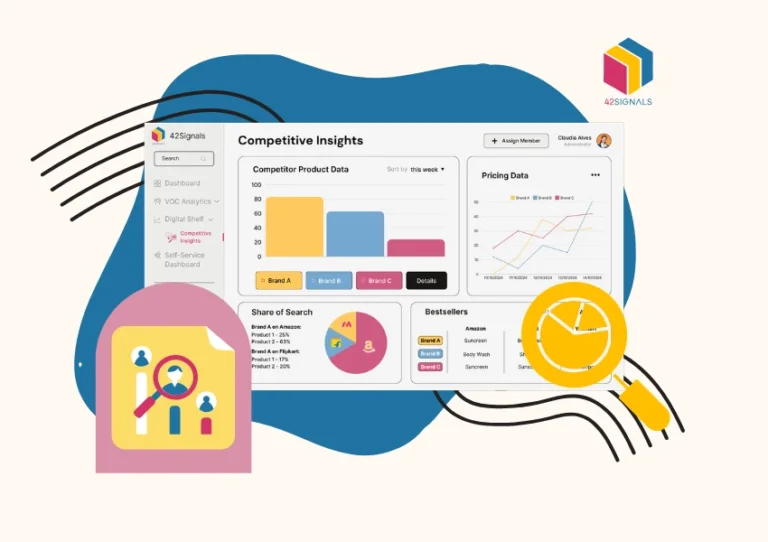- The Need for a Pricing Insights Software
- Ditching the Digital Paperwork: How Software Actually Helps
- Moving Away from a One-Size-Fits-All Dashboard to a Custom Pricing Insights Software
- In an ocean of Pricing Insights Software, What do you Prioritize?
- From Knowledge to Action
- Choosing Your Partner Software
- The Bottom Line: Turning Defense into Offense
- Frequently Asked Questions
** TL;DR ** Manually tracking competitor prices is a losing battle that leads to missed sales and eroded margins. Pricing insights software acts as your automated co-pilot, replacing guesswork with real-time data and alerts to stop MAP violations and competitor undercutting. By providing a customizable dashboard with historical trends and deep-dive analysis, it empowers your marketing, sales, and strategy teams to make smarter, proactive decisions that protect your brand value and significantly boost profitability.
How did you set the price for your top product? Was it a rigorous, data-driven decision, or more of a… well, an educated guess? If you’re feeling a twinge of recognition, welcome to the club and the need for a pricing insights software.
I want you to picture a Tuesday. You’ve just launched a promotion you’ve been planning for weeks. You’re watching the sales come in, feeling pretty good about life. Then, maybe a day or two later, you notice it. A weird dip in conversions. A sudden silence on a product page that’s usually buzzing. Your heart does that little sinky thing. You frantically check your website—is the cart broken? You check your ads—are they still running? Everything looks fine.
So, you do what we all do. You open up fifteen browser tabs. You start the manual hunt, clicking through competitor sites, scrolling through Amazon, trying to remember what everyone was charging last week. And after what feels like an hour of your life you’ll never get back, you find it. Your main rival isn’t just matching your sale; they’ve gone and undercut you by a solid twenty percent. And they’ve been doing it since yesterday.
In a world where prices can change between your second coffee and your third, this just doesn’t cut it anymore. You need a co-pilot. You need a system that does the looking for you.
Before you go, download our sample report
The Need for a Pricing Insights Software
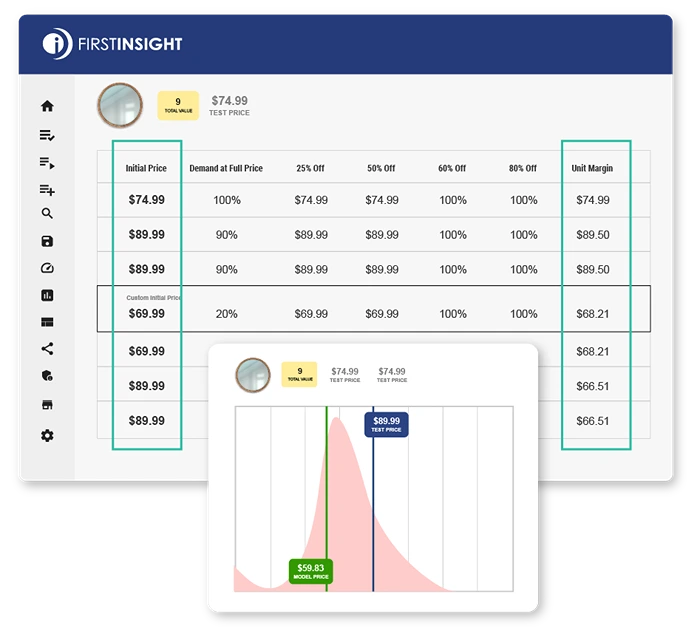
Image Source: First Insight
As consumers and businesses, pricing is always on the top of our minds. It’s weird, right? It feels like it should be so simple. Cost of goods plus margin equals price. But it’s not math; it’s psychology. That number on the tag is whispering a story to your customer about your product’s value, your brand’s prestige, and how much you respect their intelligence. Price it too high and you seem out of touch. Price it too low and you look cheap, starting a race to the bottom that nobody wins.
But the real headache is that the “right” price is a moving target. It’s influenced by stuff you can’t control. A competitor gets a new batch of inventory and decides to clear out the old stuff. A blogger mentions a rival product and it goes viral. Or, one of your own retailers decides to run an unauthorized sale, triggering what we call MAP violation triggers.
A premium pet supplies company had built its brand on quality. Then, his best-selling, high-end dog bed just stopped selling. He was ready to discontinue it. Turns out, a big-box retailer was selling it for a song online, violating their pricing agreement. This wasn’t just a lost sale; it was a brand killer. Customers who saw that deep discount started questioning the bed’s value altogether. Why pay full price from him if it’s “really” worth so much less?
The numbers behind this are sobering. The clever folks at McKinsey & Company figured out that a 1% price increase, if your sales volume holds steady, can boost your operating profits by a whopping 8.7%. Let that sink in. Conversely, a panicked, uninformed price drop can wipe out that potential profit in an afternoon. Without a system to make sense of this chaos, you’re basically gambling with your revenue. And the house always wins.
Ready to Take the Next Step?
See how our solutions can help you achieve your goals and drive measurable results.
Ditching the Digital Paperwork: How Software Actually Helps
So, how do we stop guessing? The answer isn’t hiring an intern to manually check prices all day (trust me, I’ve tried it). The solution is to use technology to do the boring, repetitive stuff for us. This means finally saying goodbye to those soul-crushing spreadsheets and hello to a dedicated pricing insights software platform.
But let’s be real about what this software does. It’s not some magical AI genius. Think of it as your most obsessive, detail-oriented employee who never sleeps. Their only job is to be your scout on the digital battlefield. They’re constantly scanning—your competitors’ sites, Amazon, Walmart, all of it—gathering intel on millions of products.
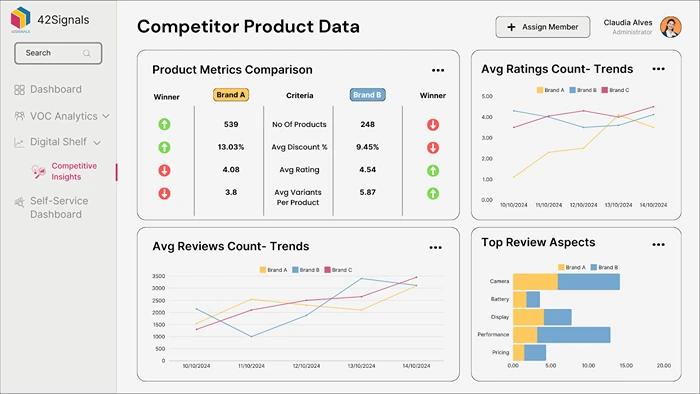
Image Source: 42Signals competitor analysis dashboard
Here’s the important part: data by itself is useless. A spreadsheet with ten thousand prices is just noise. The real value of good pricing insights software is what it does next. It takes that noise and turns it into a signal. It answers the questions that actually keep you up at night:
- “Did anyone change their price on my product today?”
- “Is my biggest competitor running a secret sale I don’t know about?”
- “Are my retailers playing by the rules, or are they triggering MAP violation triggers?”
- “What’s the actual average going rate for products like mine right now?”
This whole process is what we call ecommerce price monitoring. It’s about getting a live feed of the market’s pulse.
Moving Away from a One-Size-Fits-All Dashboard to a Custom Pricing Insights Software
A generic dashboard view can sometimes be almost useless than no dashboard at all. The head of a giant electronics firm needs to see a completely different world than the founder of a handmade soap company. A standard report will drown your one most important metric in a sea of stuff that doesn’t matter to you.
This is the entire idea behind a custom pricing dashboard. Don’t think of it as a report. Think of it as your mission control.
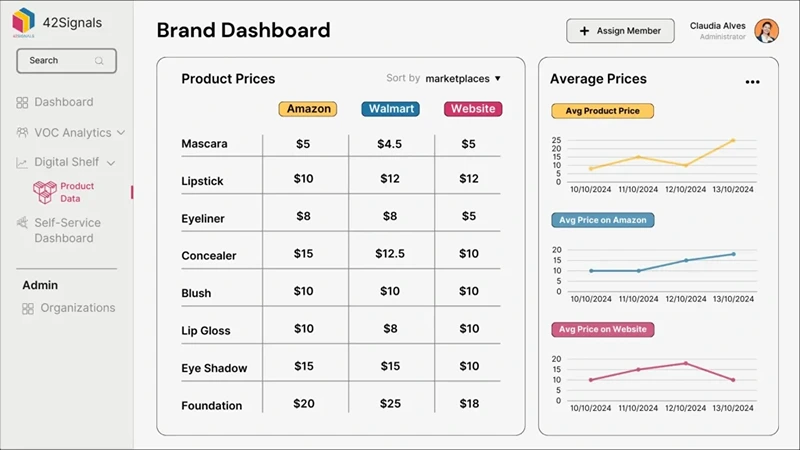
In essence, you could set up a dashboard that shows –
- The real-time prices of the three products that are your direct competition.
- A line graph tracking the average market price for your category over the last quarter.
- A special section that does nothing but watch your top retailers for any funny business with your MAP policy.
- Your own product’s price and inventory count, right there beside them.
This minutia of detail is what truly gives you the right insights to make the right decisions.
Before you go, download our sample report
In an ocean of Pricing Insights Software, What do you Prioritize?
First up, and what’s most important – real time alerts. This is the whole ballgame. The software has to be able to tap you on the shoulder the instant something important happens. I’m talking an SMS or email the second a competitor’s price drops below a line you set, or the moment it catches a MAP violation. This means you don’t have to live inside the software. The info comes to you, so you can actually respond while it still matters.
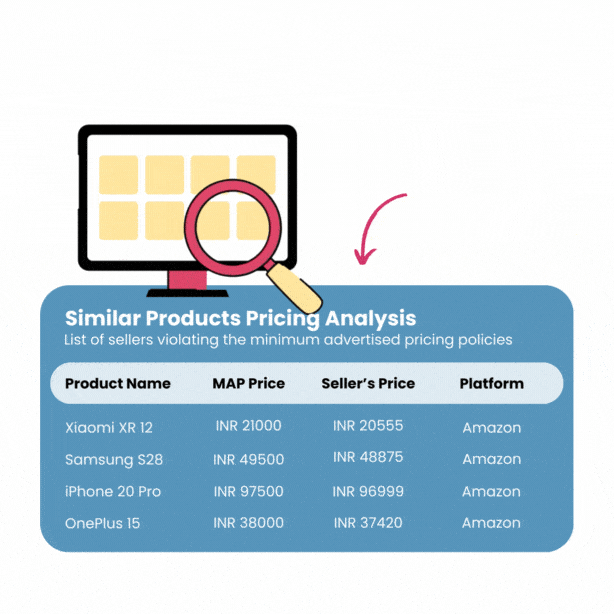
Second, you need a time machine. Well, sort of. You need deep historical data. Knowing the price right now is okay. But understanding the *story* of that price is everything. Can you pull up a chart and see how it’s changed over the last month?
Finally, you need to be able to dig. A top-level alert tells you *what* happened. Drilling down tells you *why* it might have happened and *what to do about it*. This means clicking into a detailed customer analysis dashboard view. You should see the exact retailer, the time it happened, the price history, and how your product stacks up.
From Knowledge to Action
To begin with a pricing insights software, see it this way.

Image Source: Product data and prices by 42Signals
For the Marketing Teams: Instead of a generic “20% off everything” event that kills your margin, they can use the dashboard. They can see exactly which products you have a solid price advantage on. They can then create targeted, smart promotions for just those products, with messaging that highlights the deal. Your marketing budget suddenly gets a lot more effective.
For the Sales Teams: Managing retailers becomes a conversation with data, not a argument. If a seller violates your MAP policy, your sales rep doesn’t have to make an awkward call. They pull up the **customer analysis dashboard**. They’ve got the evidence: the product, the timestamp, the history. The chat becomes, “Hey, I’m looking at our data and see your price for Product X is at $49.95, which is under our MAP of $59.99. Can we get that corrected to protect the brand for both of us?”
For the Strategy Personnel: The deep product and pricing data is a crystal ball. You might see that a competitor’s product is always 25% higher but still wins the Amazon Buy Box every time. That tells you they’ve built insane perceived value—what can you learn from that? Or, you might find a gap where everyone is priced high, revealing a perfect chance to introduce a great, more affordable option. A Forrester report found that companies using data like this grow 30%+ faster than those who don’t.
Choosing Your Partner Software
Choosing a pricing insights software provider isn’t like buying a toaster. You’re picking a business partner. You need someone who gets it—not just the tech, but the actual pain you’re feeling. This is where a solution built by people who’ve been in your shoes, like 42Signals, makes all the difference.
Our platform wasn’t built in some ivory tower. It was coded by folks who’ve felt the frustration of manual tracking. It starts with an almost nerdy obsession with data accuracy. If the info on your screen isn’t rock-solid, then every decision you make is built on sand.
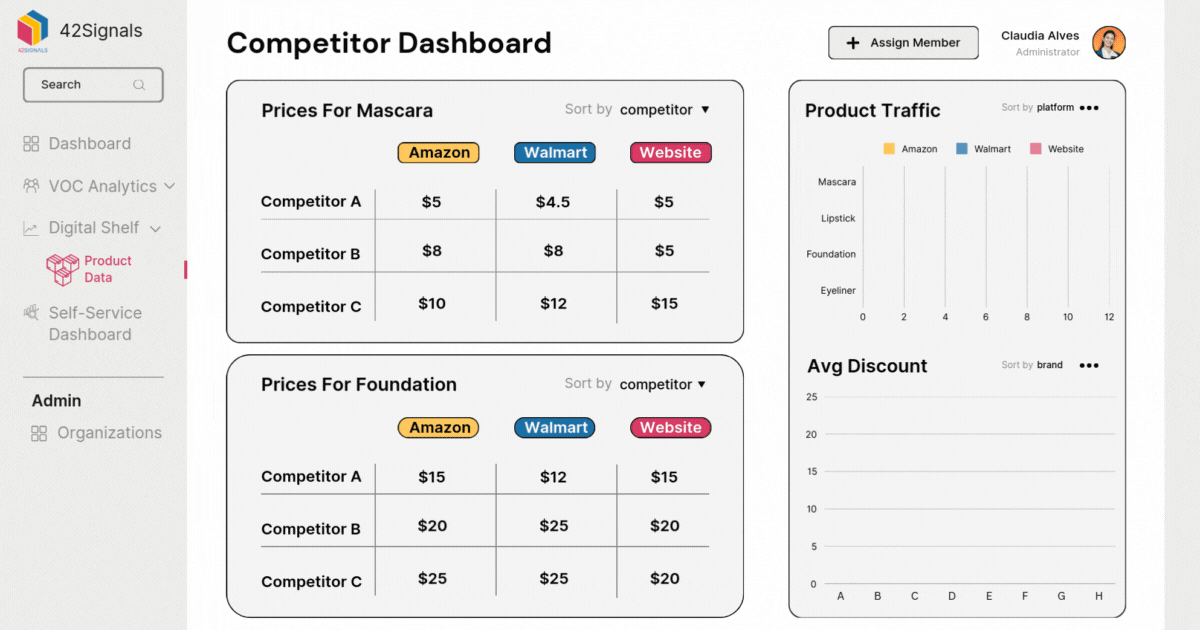
42Signals is one such pricing insights software that’s specialized and customizable to your needs. It provides the insights you need (which you pay for) and doesn’t charge you for the features you don’t use. Makes sense right?
Pro Tip:
If you’re interested in a proof of concept, schedule a demo with us today.
The Bottom Line: Turning Defense into Offense
Ecommerce isn’t going to slow down anytime soon. It’s getting faster. Prices will keep changing in the blink of an eye. New competitors will pop up overnight.
Building a powerful custom pricing dashboard with a partner like 42Signals isn’t just buying a tool. It’s building your competitive advantage. It’s how you protect your brand’s value, make smarter decisions on margin, and finally get ahead of the market instead of just reacting to it.
If you haven’t signed up for our platform yet, sign up today.
Frequently Asked Questions
A pricing insight refers to actionable information derived from analyzing pricing data and market trends. It helps businesses understand how factors like competitor pricing, customer demand, seasonality, and cost structures influence their own pricing decisions. For example, insights might reveal that lowering the price of a product by 5% during a specific season leads to a higher conversion rate, or that bundling products increases average order value. These insights guide companies toward smarter, data-driven pricing strategies.
insightsoftware, a provider of financial reporting and business intelligence tools, does not publish flat-rate pricing because its cost varies based on factors such as company size, number of users, and specific modules required. Pricing is typically customized and offered on a quote basis after evaluating a business’s needs. Most solutions follow a subscription-based model. To get exact costs, companies usually request a demo or consultation directly with insightsoftware’s sales team.
The 7 C’s of pricing are a framework businesses use to evaluate pricing strategies holistically:
Cost – The expense of producing and delivering the product.
Customers – Understanding how much buyers are willing to pay.
Competition – Benchmarking against market rivals.
Channel – Considering distribution and sales channel costs.
Compliance – Ensuring prices meet legal and regulatory requirements.
Consistency – Aligning prices with brand positioning and strategy.
Communication – Clearly conveying the value of the product to justify its price.
This framework helps companies set prices that are competitive, compliant, and aligned with customer expectations.
The four most common pricing methods are:
Cost-plus pricing: Setting prices by adding a markup to production costs.
Value-based pricing: Pricing based on the perceived value of the product or service to the customer.
Competition-based pricing: Setting prices relative to competitors’ pricing.
Dynamic pricing: Continuously adjusting prices based on market demand, inventory levels, and real-time conditions.
Each method works differently depending on the industry, product lifecycle, and business goals.



